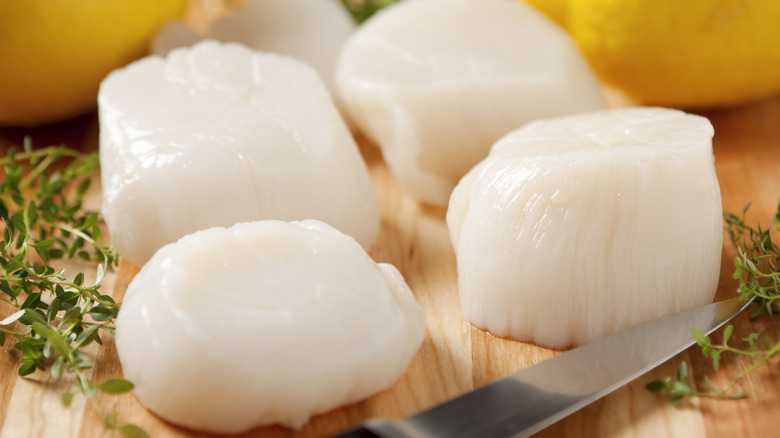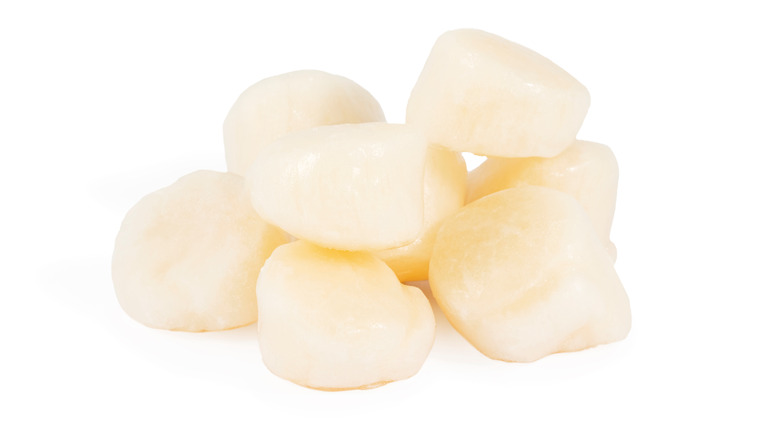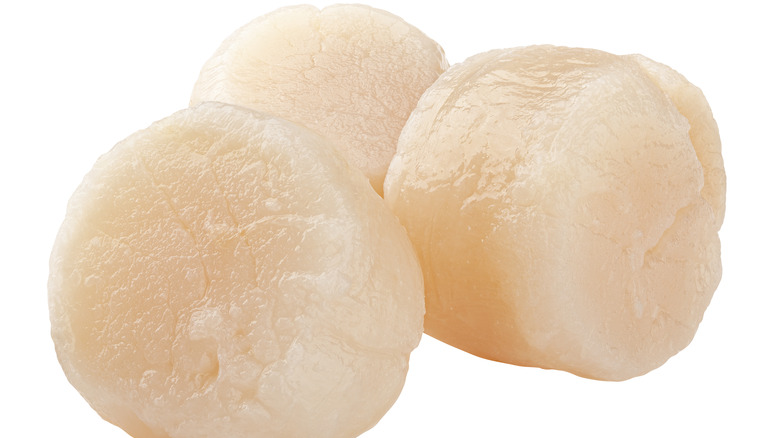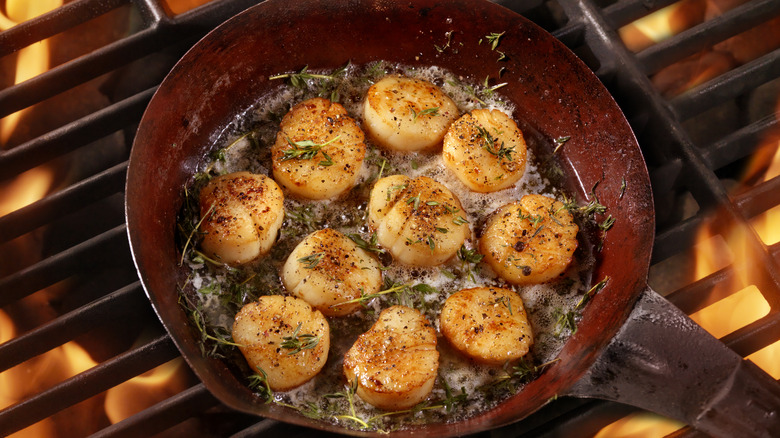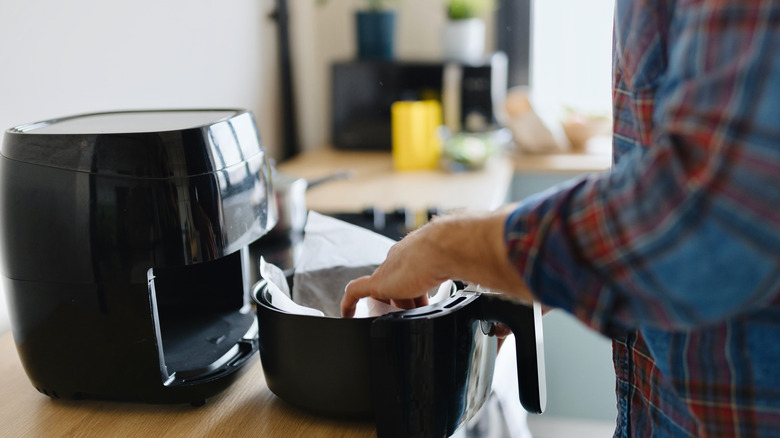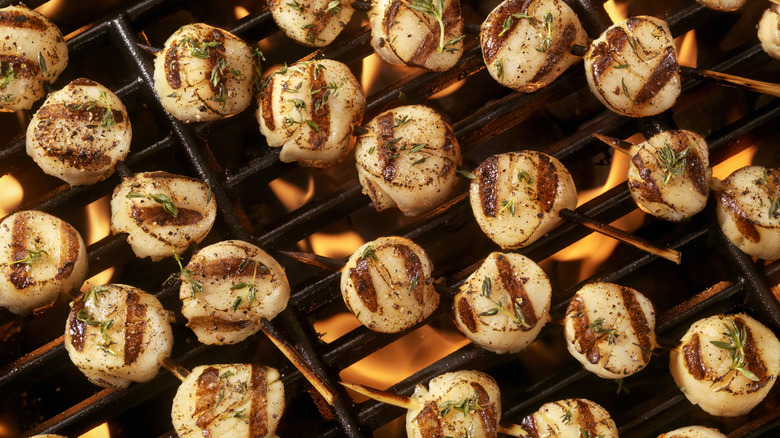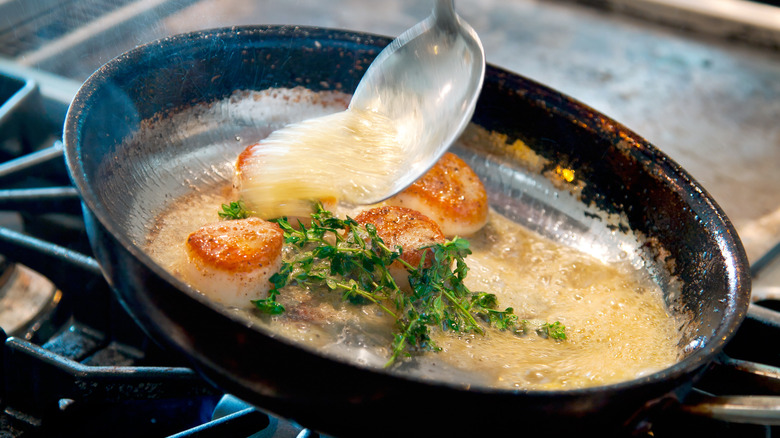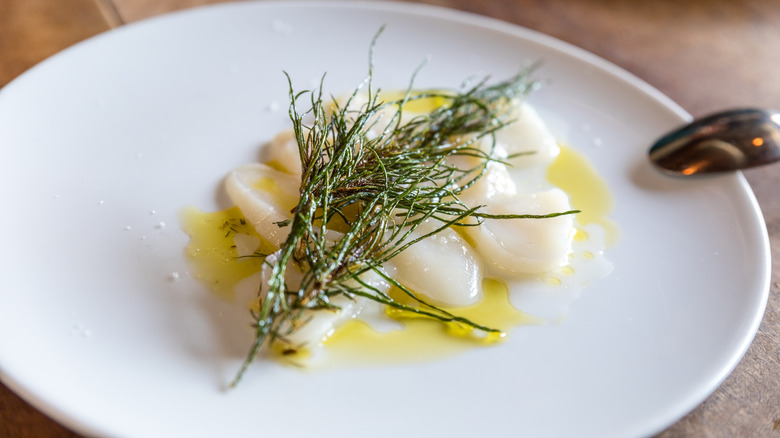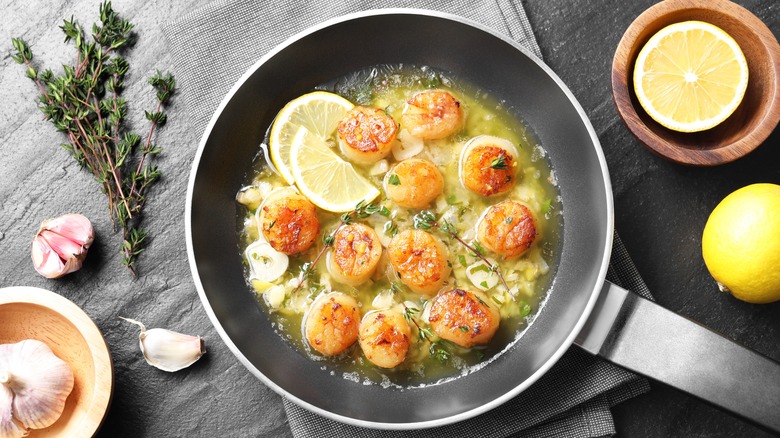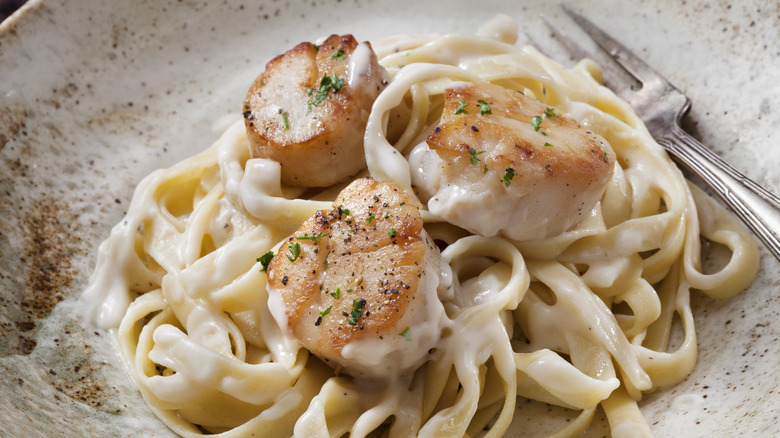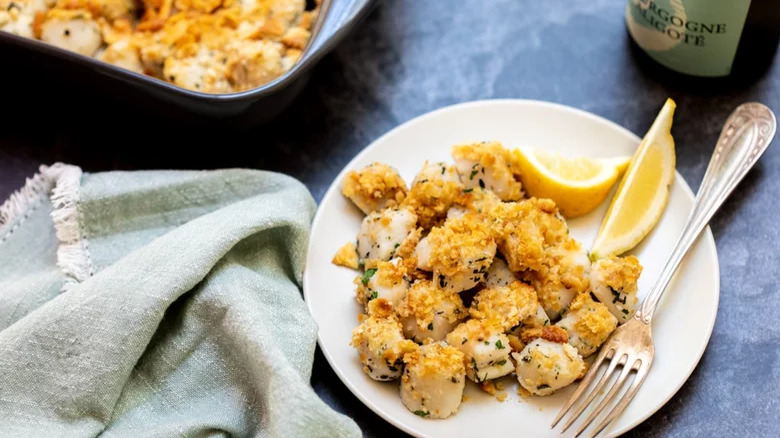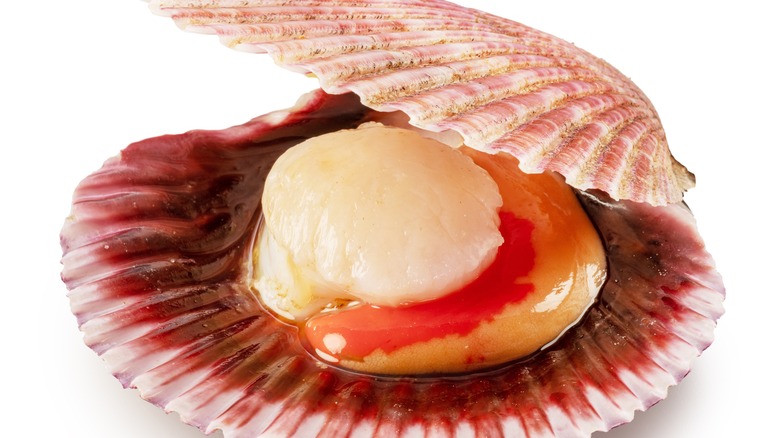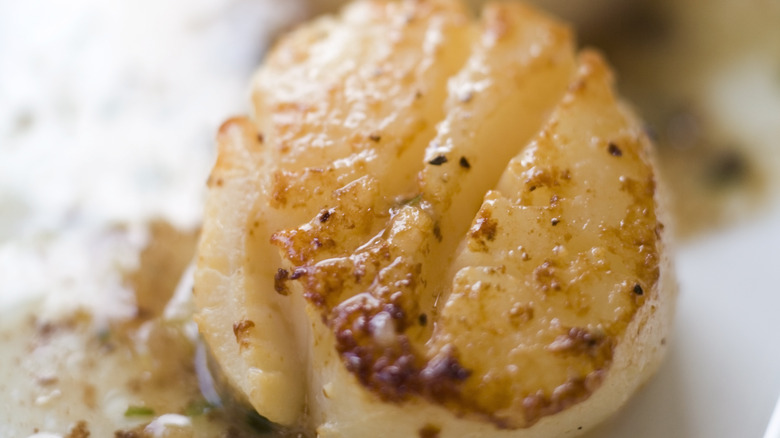12 Ways To Seriously Upgrade Scallops
Scallops don't need much to be outstanding. These little morsels are known for their soft, meaty texture and rich, sweet aroma with just a touch of the briny flavor of the sea. That said, a little bit of knowledge goes a long way towards making your scallops truly extraordinary.
Things start at the fishmonger, where you'll have a number of choices regarding the type of scallops you buy. Sea scallops are the biggest and meatiest, measuring around 2 inches in diameter. Bay scallops, on the other hand, are smaller, just a half-inch wide. Slightly sweeter than sea scallops, bay scallops are also a less expensive option. That said, when people mention scallops without stating which ones they mean, they're typically referring to sea scallops.
In the case of sea scallops specifically, your first course of action upon getting them home will be to remove the "foot," the muscle that helps adhere the scallop to the shell. Far tougher than the scallop itself, it can be carefully pulled away from the main meat and either discarded or saved to make a stock or a broth.
Once you've made it that far, it's time to cook. Here are the best ways to push your scallops into next-level deliciousness.
1. Opt for dry scallops
At the fishmonger, you don't just need to choose the size of your scallops — you also need to choose the way they've been prepared and treated before making it to your kitchen. Some scallops, termed "wet scallops," are preserved in sodium tripolyphosphate immediately after being caught. This treatment gives them a slightly longer shelf life, but, along with the fact that they're usually also frozen, it also means their texture and flavor are diminished. They can be tougher and bouncier when cooked, and their flavor may be slightly chemical or even soapy. And the added moisture that comes from this treatment means that it can be difficult to get a good sear on them.
Instead, choose dry scallops whenever you can. These scallops will taste fresher and won't have any off flavors. Plus, the fact that they don't have as much residual moisture means they'll be easier to sear to caramelized perfection.
2. Don't forget to brine your scallops
Given their innate sweetness and balanced brininess, it doesn't take much seasoning to make scallops perfect. But if you want to make them even tastier, a touch of salt will make a world of difference — especially if you season them both inside and out. Brining scallops may sound technical, but it's as easy as adding them to a saltwater solution. After just ten minutes, the scallops will have absorbed some of the salt and plumped up a bit. Adding a touch of lemon to the water will lend even more brightness.
Plus, if wet scallops were the only ones you could track down, brining them may help improve their texture. The saltwater solution can help remove some of the slightly chemical taste wet scallops have, making them nearly as delicious as dry. Just be sure that you pat the surface of the scallops dry after brining to ensure you can get a good sear on them once they hit the hot pan.
3. Cook scallops over very high heat
The delicacy of scallops could lead you the believe it's a good idea to cook them gently, over low heat. In reality, the opposite is true: A hard sear will give you a nice, crisp crust on the outside and keep the scallops tender within.
The best method of getting the perfect sear starts by patting them dry with paper towels to ensure there's no remaining moisture, which will keep that sear from forming. Next, grab a heavy-duty pan like a cast iron skillet and a cooking fat with a high smoke point like grapeseed oil, which smokes at 420 degrees Fahrenheit. Heat over medium-high, and when the oil is hot, add the scallops, taking care not to move them for the first minute or two, which will give you ample opportunity for the Maillard reaction to take place and give you that lovely crust. Flip them over and cook until you reach an internal temperature of 115 degrees for the best blend of a crisp exterior and tender interior.
4. Use the air fryer for the perfect scallops
While a ripping hot pan is an excellent tool when cooking scallops, it's not the only way you can go. Air fryer scallops are a total breeze thanks to the air fryer's use of convection heat. The air fryer has a built-in fan that blows hot air all around the food, helping it cook faster on the outside while the inside remains tender.
To use the air fryer to cook bay scallops, first preheat it to 400 degrees Fahrenheit. Season the scallops — butter, salt, and pepper is a great starting point, but feel free to get creative with spices if you like. Once they go into the air fryer, bay scallops need just five minutes on their own — and an additional five minutes after being drizzled in a lemon-butter sauce — to reach perfection. Serve them by themselves or with a side of rice to soak up any excess sauce.
5. Cook scallops on the barbecue for char-grilled flavor
Grills are yet another source of ripping hot heat, reaching 450 or even 500 degrees Fahrenheit, which makes them perfect for cooking scallops. Grilled scallops get lovely char marks and caramelized notes, not to mention a slight smokiness that's only magnified if you pair them with one of their best friends, bacon (We all know Ron Swanson loves bacon-wrapped shrimp, so he'd probably love bacon-wrapped scallops too).
Of course, grilling scallops can also be a bit more difficult than pan-searing them. It's easy for scallops to stick to a poorly maintained grill — or even to slip through the grate. Consider making scallop kabobs, sliding the scallops onto wooden skewers that have soaked in water for at least 30 minutes to keep them from burning. You can also marry the best of pan-cooking and grilling by cooking scallops in a cast iron pan placed directly on the grill.
6. Undercook your scallops slightly for the perfect texture
No matter which heat source you choose, most experts agree: An undercooked scallop is way more palatable than an overcooked one. It only takes moments to push scallops into overcooked territory, at which point they become rubbery, chewy, and dry — hardly the terms you want your guests to describe your food with, especially when the main ingredient is so expensive. For this reason, some cooks choose to sear scallops on one side only, finishing the other side by basting them with butter off the heat. This technique reduces the amount of direct heat the scallops endure, ensuring that they won't overcook during the time it takes to get them from the stove to the table.
Of course, keeping your scallops from overcooking isn't just your job — you also need help from your guests. If you're serving scallops at a dinner party, make sure everyone is already seated before the scallops ever land in the pan to make sure they aren't sitting around waiting for people to take their seats.
7. Serve scallops raw
Perhaps the simplest way to take full advantage of all of the rich, sweet flavor of scallops is to serve them raw, as in a crudo, which sees the thinly sliced scallops simply seasoned with olive oil, citrus, salt, and pepper and served immediately to keep the acid from denaturing them. Scallops can also be diced and transformed into a tartare or draped across mounds of sushi rice for scallop nigiri. While these preparations are not technically raw since acid "cooks" the scallop meat, marinating scallops gently in citrus can make a particularly delicious ceviche or tiradito.
If you're going to serve raw scallops, you'll definitely want to opt for fresh, dry scallops rather than wet or frozen, taking care to pick scallops that smell mildly of the sea without any off aromas. Any scallops that smell fishy or look slimy should be avoided. Not only will they have the best flavor, but they'll also likely be fresher.
8. Add a butter sauce to your scallops
Scallops are already rich all on their own, but you can gild the lily with an equally rich butter sauce. Basting the scallops with butter will lend a buttery flavor to the scallops themselves and allow the cooking juices of the scallops to mix with the butter, creating a flavorful sauce. Infusing butter with garlic or chile will help the scallops pop, as in our recipe for scallops with chile-garlic butter sauce. If you'd like something richer, a classic beurre blanc, made by emulsifying butter with white wine seasoned with shallot and enriching with cream, is just the ticket.
Browning the butter before you use it is another way to help the sweetness of the scallops really pop. Brown butter is made by slowly caramelizing the milk solids in the butter until they are nutty and toasted. Take care not to burn the butter, as this can introduce bitter notes that will ruin not just the butter but the expensive scallops.
9. Add a cream sauce to your scallops
For even more richness, consider pairing your scallops with a cream sauce. A combination of garlic, wine, and cream makes a delicious sauce that gains a touch of brightness thanks to fresh parsley and cayenne pepper, and a bit of lemon will make everything pop. Or you can make things even richer by pairing scallops with a cheesy alfredo sauce. Who cares what people say about seafood and cheese not working well together? While it may be taboo to some, many experts think the combo is heart-stoppingly delicious.
Scallops and cream sauce can easily be served all on their own, but that tasty sauce is just begging for some sort of carbohydrate to soak up every last drop. Toss the scallops and cream sauce with spaghetti, ladle over mashed potatoes, or serve alongside a hunk of crusty bread to mop it all up.
10. Transform scallops into a crunchy casserole
A scallop casserole sounds like the sort of dish that shouldn't work ... and yet it does, so very well. The ultimate mashup between a luxe ingredient and a comfort food staple, this recipe comes together in just 15 minutes, pairing scallops with white wine, garlic, shallots, and butter and topping them with a crispy cracker crust. You can also add crunch to your scallops a la Legal Sea Foods with this copycat baked scallop recipe, which takes advantage of the subtle tang of buttermilk to add even more nuance to the scallops before they're topped with buttery Ritz crackers for crunch.
Bigger sea scallops — especially ones in their shells — can also take advantage of all that buttery crunch. Simply combine the butter, breadcrumbs, and any seasoning you like and sprinkle the mixture on top of the scallops. Bake for 15 minutes, broiling for the last minute to brown the crust, and you'll end up with a beautiful individual portion perfect for a dinner party.
11. Transform scallop roe into a lovely sauce
Occasionally, when you buy scallops, the bright orange roe will still be attached to the meat. This sac of scallop eggs is deeply flavorful and can be used in a number of ways. First, most chefs detach it from the scallop itself, as it has a tendency to cook more quickly than the meat. Once it's removed, however, there are many ways to take advantage of its flavor. Some cooks dunk it in tempura batter and deep fry it to add texture to the dish, while others pan-fry it with garlic, lemon, and butter to serve alongside the scallops.
Perhaps the most common way to use scallop roe, however, is in a sauce. Cooking the roe with shallots and white wine before blending it with a touch of cream gives you a lovely orange-hued sauce that's the perfect counterpart to the creamy white scallops.
12. Add truffles to your scallops
What's better than one luxe ingredient? Two! Scallops and truffles are a pretty classic pairing, with the rich, slightly sweet scallops standing up well to the earthiness of black truffle. As for how you integrate truffle into your scallop dish, there are loads of possibilities at your disposal. A rich, truffle-infused beurre blanc sauce may be the picture of luxury, while topping a truffle-infused mushroom risotto with seared scallops doesn't just double down on the earthiness, it transforms the pairing into a meal.
Of course, truffles can get expensive, and when you consider the price of scallops — an average of between $8 and $16 a pound — such a pairing starts shaping up to be a pricy meal indeed. Relying instead on cheaper sources of truffle flavor like truffle oil or truffle salt is a good compromise that will give you some of the truffle's perfume without breaking the bank.
